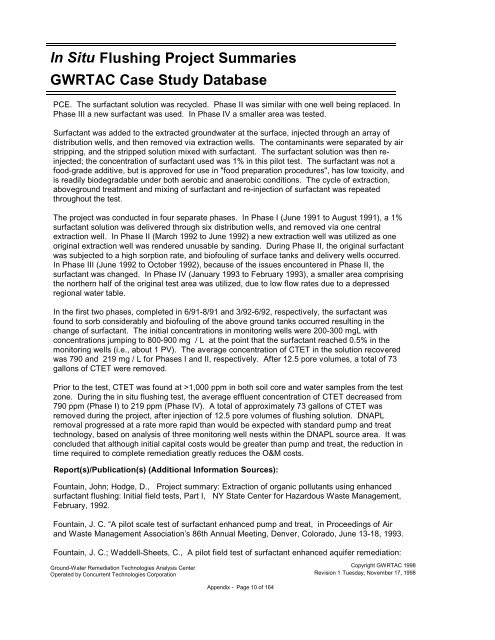Technology Status Report: In Situ Flushing - CLU-IN
Technology Status Report: In Situ Flushing - CLU-IN
Technology Status Report: In Situ Flushing - CLU-IN
Create successful ePaper yourself
Turn your PDF publications into a flip-book with our unique Google optimized e-Paper software.
<strong>In</strong> <strong>Situ</strong> <strong>Flushing</strong> Project Summaries<br />
GWRTAC Case Study Database<br />
PCE. The surfactant solution was recycled. Phase II was similar with one well being replaced. <strong>In</strong><br />
Phase III a new surfactant was used. <strong>In</strong> Phase IV a smaller area was tested.<br />
Surfactant was added to the extracted groundwater at the surface, injected through an array of<br />
distribution wells, and then removed via extraction wells. The contaminants were separated by air<br />
stripping, and the stripped solution mixed with surfactant. The surfactant solution was then reinjected;<br />
the concentration of surfactant used was 1% in this pilot test. The surfactant was not a<br />
food-grade additive, but is approved for use in "food preparation procedures", has low toxicity, and<br />
is readily biodegradable under both aerobic and anaerobic conditions. The cycle of extraction,<br />
aboveground treatment and mixing of surfactant and re-injection of surfactant was repeated<br />
throughout the test.<br />
The project was conducted in four separate phases. <strong>In</strong> Phase I (June 1991 to August 1991), a 1%<br />
surfactant solution was delivered through six distribution wells, and removed via one central<br />
extraction well. <strong>In</strong> Phase II (March 1992 to June 1992) a new extraction well was utilized as one<br />
original extraction well was rendered unusable by sanding. During Phase II, the original surfactant<br />
was subjected to a high sorption rate, and biofouling of surface tanks and delivery wells occurred.<br />
<strong>In</strong> Phase III (June 1992 to October 1992), because of the issues encountered in Phase II, the<br />
surfactant was changed. <strong>In</strong> Phase IV (January 1993 to February 1993), a smaller area comprising<br />
the northern half of the original test area was utilized, due to low flow rates due to a depressed<br />
regional water table.<br />
<strong>In</strong> the first two phases, completed in 6/91-8/91 and 3/92-6/92, respectively, the surfactant was<br />
found to sorb considerably and biofouling of the above ground tanks occurred resulting in the<br />
change of surfactant. The initial concentrations in monitoring wells were 200-300 mgL with<br />
concentrations jumping to 800-900 mg / L at the point that the surfactant reached 0.5% in the<br />
monitoring wells (i.e., about 1 PV). The average concentration of CTET in the solution recovered<br />
was 790 and 219 mg / L for Phases I and II, respectively. After 12.5 pore volumes, a total of 73<br />
gallons of CTET were removed.<br />
Prior to the test, CTET was found at >1,000 ppm in both soil core and water samples from the test<br />
zone. During the in situ flushing test, the average effluent concentration of CTET decreased from<br />
790 ppm (Phase I) to 219 ppm (Phase IV). A total of approximately 73 gallons of CTET was<br />
removed during the project, after injection of 12.5 pore volumes of flushing solution. DNAPL<br />
removal progressed at a rate more rapid than would be expected with standard pump and treat<br />
technology, based on analysis of three monitoring well nests within the DNAPL source area. It was<br />
concluded that although initial capital costs would be greater than pump and treat, the reduction in<br />
time required to complete remediation greatly reduces the O&M costs.<br />
<strong>Report</strong>(s)/Publication(s) (Additional <strong>In</strong>formation Sources):<br />
Fountain, John; Hodge, D., Project summary: Extraction of organic pollutants using enhanced<br />
surfactant flushing: <strong>In</strong>itial field tests, Part I, NY State Center for Hazardous Waste Management,<br />
February, 1992.<br />
Fountain, J. C. “A pilot scale test of surfactant enhanced pump and treat, in Proceedings of Air<br />
and Waste Management Association’s 86th Annual Meeting, Denver, Colorado, June 13-18, 1993.<br />
Fountain, J. C.; Waddell-Sheets, C., A pilot field test of surfactant enhanced aquifer remediation:<br />
Ground-Water Remediation Technologies Analysis Center<br />
Operated by Concurrent Technologies Corporation<br />
Appendix - Page 10 of 164<br />
Copyright GWRTAC 1998<br />
Revision 1<br />
Tuesday, November 17, 1998
















